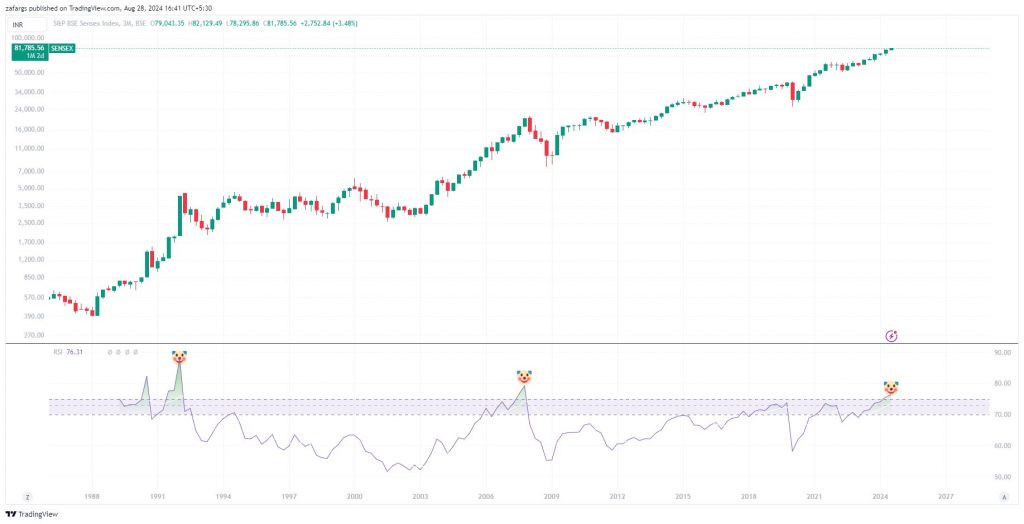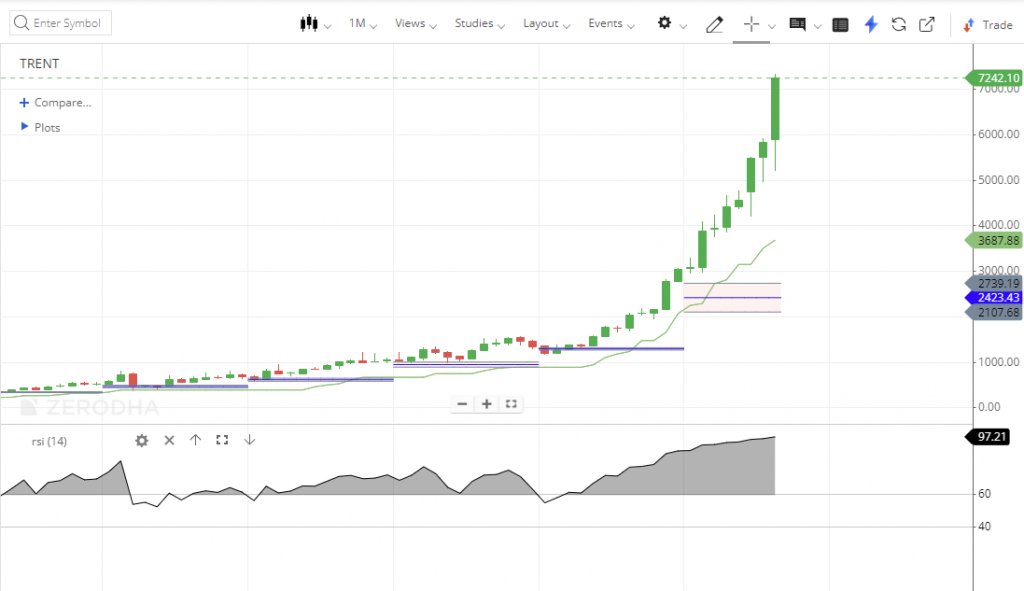One interesting observation from the below enclosed BSE long-term analysis chart is the behavior of the Relative Strength Index (RSI). RSI is a tool that measures the speed and change of price movements, often indicating whether a market is overbought or oversold. Typically, an RSI above 75 is considered overbought, which could suggest that the market might soon correct itself. However, it’s essential to remember that just because the RSI is high doesn’t mean a market drop is imminent.

The Pitfalls of Relying Solely on RSI
Many investors might assume that a high RSI guarantees a market fall, but that’s not always true. The BSE Sensex has shown periods where the RSI remained in the overbought zone for extended periods without any significant market correction. The phrase “markets can remain irrational longer than you can remain solvent” rings true here. It’s a reminder that while RSI is a valuable tool, it should not be the sole basis for making investment decisions. Market trends can continue upward even when indicators suggest they shouldn’t.
Taking a closer look at specific stocks like Trent, we see similar patterns.

Trent’s RSI reached an impressive 97 on the monthly chart, signaling an extreme overbought condition. If an investor had exited their position based solely on the high RSI, they would have missed out on a substantial rally from 2000 to 7000 points. This example underlines the importance of not using RSI in isolation. It’s just one piece of the puzzle, and other factors should be considered before making any buying or selling decisions.
The Importance of Combining Indicators
While RSI can highlight overbought or oversold conditions, it doesn’t predict what will happen next. To make more informed decisions, it’s crucial to combine RSI with other indicators. For instance, you can look at price-based trends, moving averages, or other tools like supertrend indicators. By doing so, you can get a more comprehensive view of the market’s direction. If multiple indicators point to a potential downturn while the RSI is high, then it might be time to consider adjusting your positions.
Relying on just one indicator, such as RSI, can lead to missed opportunities or poor decisions. Markets are complex and influenced by various factors that a single indicator might not capture. It’s essential to have a broader strategy that incorporates multiple tools and perspectives. By diversifying your approach, you reduce the risk of making decisions based on incomplete information, leading to better long-term results.
Mi EverGreen’s Subscription Fee goes up on 10 Sep 2024
Effective 10 Sept 2024 , Mi EverGreen’s subscription fee will be increased for the first time since launch.
Old Pricing : Rs 2,499 (Quarterly) | Rs 7,499 (Annual)
New Pricing : Rs 4,999 (Quarterly) | Rs 14,999 (Annual)
For Current Subscribers of Mi Evergreen
Nothing changes for current subscribers at all. You shall continue to enjoy access to the strategy at your current subscription fee as long as you do not break your subscription loop. Kindly ensure that you keep your auto renew ON and renew your subscription on time.
For those who haven’t subscribed yet
This is a great opportunity to subscribe to Mi Evergreen at its current pricing. Use the link given below to subscribe
Disclaimers and disclosures : https://tinyurl.com/2763eyaz
If you have any questions, please write to support@weekendinvesting.com













